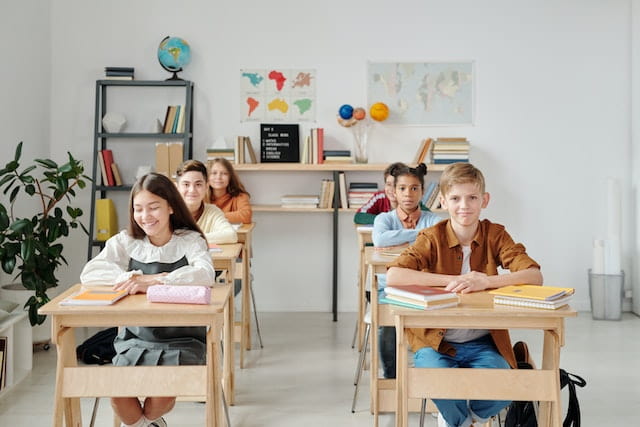The environment where learning takes place holds extraordinary power in nurturing young minds. It ignites curiosity, inspires creativity, and shapes children’s perspectives. As their parents and guardians, you can help craft this essential space to make it the perfect learning environment.
This article will guide you in understanding what constitutes an ideal learning space. Whether you’re navigating Abu Dhabi private schools in search of the best educational fit or redesigning a study area within your home, reading this article can give you valuable insights in providing the best learning environment for your child.
5 Things That Make Up the Ideal Learning Environment
The learning environment holds a unique and profound influence on a child’s education. But what is it exactly?
According to experts, a learning environment is a multifaceted concept encompassing physical and psychological aspects. Physically, it includes:
- The layout of classrooms
- The arrangement of furniture
- The availability of materials and technology
- Visual cues like posters
- Appropriate lighting
- Safety considerations
When students step into a classroom or sit down to study at home, the surroundings can either enhance or hinder their ability to concentrate, absorb information, and engage in productive learning. It’s not just about the aesthetics; it’s about functionality and purpose.
When determining a suitable location for your children’s study sessions – be it in school or at home, take into account the following aspects:
1. Quiet environment
Concentration is the cornerstone of effective learning. Background noise can break your child’s concentration. Minimize it as much as possible. You can achieve this by selecting a quiet study location or using noise-canceling headphones if external noise is unavoidable.
A quiet environment allows your child to concentrate without being disturbed by other people or noise. Choose a space that minimizes external disruptions (more on this later).
When your child can focus on their studies, they absorb information more efficiently and engage in productive learning.
2. Adequate space
Always remember the Goldilocks rule when it comes to the size of the physical learning space – not too cramped, yet not overly spacious.
Your child should have enough room to reach everything they need without feeling cramped. Moreover, the area must be organized to ensure that all their school supplies are within arm’s reach and lessen the need to search for items during study sessions.
3. Proper lighting
The room lighting plays a key role in maintaining focus. Well-lit spaces make it easy for students to read and complete their assignments. Of course, the lighting should be comfortable and adjustable to cater to different tasks.
Research reveals that natural light and other sources of blue light can enhance productivity, improve mood, and support learning. Considering this, try to position your child’s study area near a sunny window or in a room with ample natural light.

If there’s no available space with ample natural lighting, go for the next best thing: LED lights. Experts in residential interior design recommend these because they:
- Mimic natural light.
- Can be adjusted to complement natural light levels.
- Emit light in a spectrum range that enhances productivity and learning.
- Are energy-efficient.
- Produce less heat.
- Have a longer lifespan than other types of bulbs.
To further enhance focus, consider reducing glare on computer screens and desktops. You can achieve this by turning down direct lighting or using diffused light sources. Desktop task lamps can also be valuable for illuminating books and papers effectively.
4. Ideal temperature
Keep the temperature in mind when designing your child’s study space or looking into school classrooms because extreme heat or cold can be distracting.
Ensure the room is at a comfortable temperature (21-25.5°C or 70-78°F) so your child can focus on their work without being disrupted by the heat or cold.
5. Free from distraction
Whether big or small, distractions can derail a student’s learning process. They can divert attention, disrupt concentration, and hinder the absorption of information. You need to minimize or eliminate these distractions to create an environment that nurtures concentration.
One of the primary sources of distraction for students is electronic devices. Even when set to silent mode or powered off, they can tempt your child to divert their attention. With social media and the internet, online distractions are also a significant concern for parents and educators.
Ensure that all electronic devices, including TVs, radios, smartphones, and tablets, are turned off or placed in a different room during study time. This also applies to schools unless some of these devices are used for learning. If it’s necessary to bring them, make sure the school you choose enforces strict rules on their use.
Balancing Classroom and Home Learning
Students learn more efficiently and effectively when there is synergy between their school and home setup. In other words, creating an environment outside of school conducive to learning is essential to reinforce the lessons they learn in the classroom.
Conversely, teacher-parent communication must remain open and consistent. Parents must have a clear understanding of what is taking place in the classroom, how their child’s progress is being measured, and any information about examinations or tests.
Foster Learning With the Ideal Space
You can create the ideal learning space that considers physical and psychological elements to support and enhance your child’s learning.
By providing the right learning environment for your child, you’re helping ease their educational journey and making a difference in their future.

